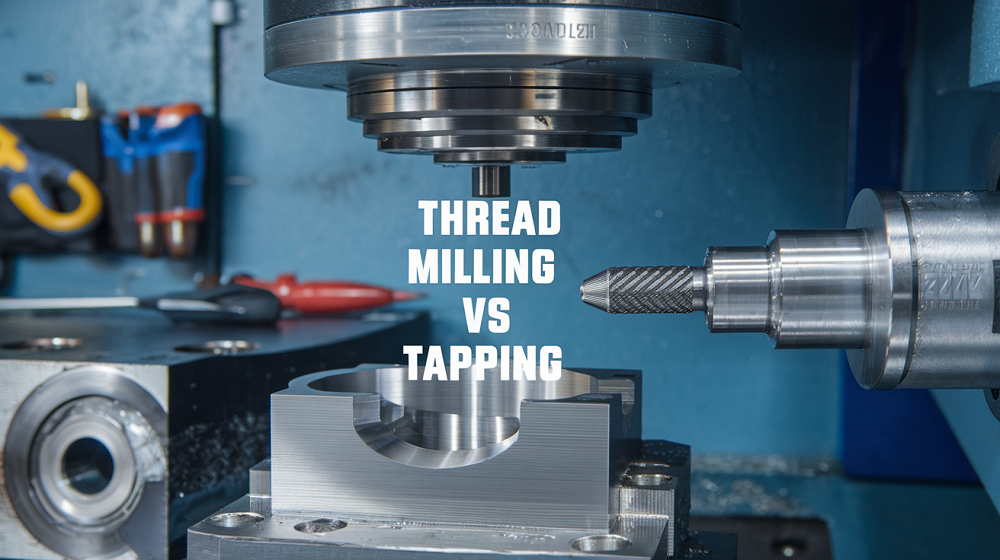Thread milling and tapping are two commonly utilized machining procedures for developing internal strings in different products, each offering distinctive benefits and disadvantages that make them appropriate for different applications. Thread milling is a multi-tooth milling procedure that involves utilizing a revolving tool to cut strings into the work surface. Since thread milling employs a circular motion integrated with direct feed, it permits for the creation of threads in materials that are difficult or weak, which would certainly or else be challenging for tapping procedures.
With tapping, any misalignment throughout the threading procedure can result in harmed strings or even damaged taps, which can be costly in terms of both time and sources. In contrast, thread milling lessens the probability of such issues due to its lowered cutting pressures and enhanced versatility, allowing for less complicated tool course changes in multi-axis CNC devices. Thread milling can create threads with greater accuracy and better surface area finishes, which is frequently crucial in high-precision applications such as aerospace and medical tool production.
Discover thread milling vs tapping the important differences in between thread milling and tapping, 2 crucial machining procedures for inner thread development, to establish one of the most appropriate technique for your tasks.
On the contrary, thread milling requires a different setup, typically employing a CNC milling equipment and specially made thread mill cutters. While thread milling devices can be a lot more expensive upfront due to their complexity and style, the long life and adaptability usually offset the first investment. Thread mills can be made use of to develop a variety of thread sizes, while taps have a tendency to be more application-specific, needing extra stock and upkeep expenses.
Tool life is one more important variable to think about when choosing in between tapping and thread milling. In addition, thread milling can suit much deeper threads, which advantages the machining of blind openings where tapping might not give the same results. The threading depth for tap applications is frequently restricted, whereas thread milling can go beyond these restrictions, adding better to its versatility.

Another factor to consider when selecting in between thread milling and tapping is the facet of threading tolerance. The precision and tolerance levels achieve structural stability in the parts being made. Thread milling enables tighter tolerances, given its capability to change feed prices and the high quality of the created thread types. This characteristic makes it especially appealing for industries where security and integrity are paramount, such as automobile, aerospace, and biomedical industries. These business typically need threads that mesh effortlessly and can resist considerable stress and stress without threat of failing.
In many instances, the decision to use either thread milling or tapping may come down to the certain application handy. If a supplier requires to create an extremely accurate thread in a personalized size and form within a hard material, thread milling would likely be the a lot more appropriate option. Alternatively, if they need to create high volumes of parts with straightforward, basic strings in softer products, tapping might supply a much more effective option. Yet, as innovation continues to advance, it is not unusual to see hybrid techniques being employed, where both methods are used in conjunction to balance production effectiveness and price with top quality and accuracy.
Environmental considerations likewise play a growing role in the selection of machining procedures. Thread milling systems tend to generate less scrap material contrasted to tapping, which can cause reduced waste and an extra sustainable production process. Furthermore, thread milling operations normally need less power intake with time, particularly in high-production settings where device life and efficiency are essential elements for success. Sustainable manufacturing methods are ending up being extra vital to makers and customers alike, making the performance of procedures like thread milling specifically appealing in today's market.
Thread milling usually supplies increased safety, as the layout and operation of milling tools reduce the possibility of such abrupt failings. CNC milling machines usually have integrated safety and security features that additionally alleviate dangers associated with tooling, offering a controlled atmosphere that can be essential in making certain the security of drivers.
As companies increasingly strive to boost making processes and outputs, understanding the ins and outs of both thread milling and tapping provides a beneficial possibility for organizations to maximize their procedures. Evaluating elements such as material kinds, required thread measurements, production volume, and spending plan restraints is essential in making the very best choice. Each approach provides one-of-a-kind attributes that can be leveraged to enhance efficiency, boost quality, and reduce expenses. While tapping may provide an effective option in details situations, especially for basic strings in softer products, thread milling proves useful in settings that call for versatility, precision, and the capability to collaborate with a variety of materials.
In verdict, the selection between thread milling and tapping expands beyond simple preference; it incorporates a broad spectrum of factors including material buildings, thread specifications, and total manufacturing goals. Whether via tapping or thread milling, the supreme aim stays the very same: to accomplish top notch threaded functions that meet the rigid demands of contemporary production while thinking about cost-effectiveness and manufacturing sustainability.
